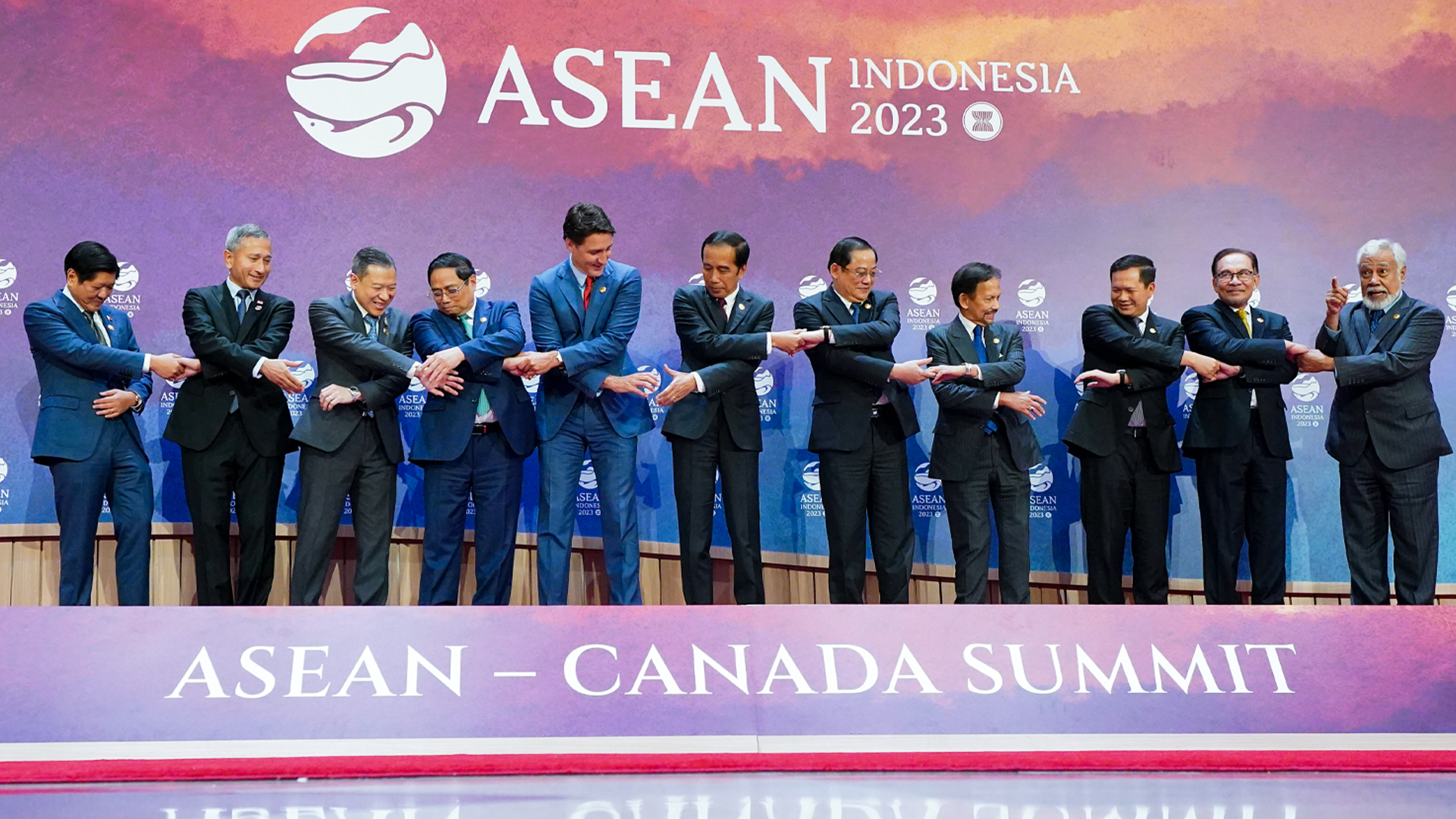
Less than a year after the release of Canada’s Indo-Pacific strategy, the federal government can celebrate its first major victory.
Prime Minister Justin Trudeau left the summit in Jakarta between Canada and the Association of Southeast Asian Nations (ASEAN) in September with a significant win in the form of a new strategic partnership with the 10-member bloc.
But can Ottawa follow through on these commitments to consistently engage with the region?
The Indo-Pacific strategy is a government-wide plan to help promote security, prosperity and sustainable development in the area through a comprehensive and inclusive approach. It also seeks to advance Canada’s interests and values while contributing to a larger-scale effort to ensure a stable and rules-based order in the Indo-Pacific region.
The recent increase in public announcements and initiatives is a much-welcomed start, but the long-term success of the strategy requires two key things: enhanced strategic alliances with our Indo-Pacific regional partners and broader support for the approach from Canadian civil society.
Strategic signaling to ASEAN and allies
To achieve success, Canada must first signal clearly to its Indo-Pacific partners what its intentions are in the region and what priority it puts on strategic relationships.
Like many other countries’ Indo-Pacific strategies, a common element of Canada’s is its characterization of China as an assertive and “increasingly disruptive global power.”
The strategy also makes a key pivot toward “ASEAN centrality in the region.” Yet as a diverse group, ASEAN member states have traditionally maintained a delicate balance in the regional superpower competition between the United States and China. Countries such as Vietnam have taken a pragmatic approach through bamboo diplomacy, which embodies neutrality through flexibility and pragmatism.
Within the framework of the Indo-Pacific strategy, Canada’s pursuit of shared democratic values and economic ties with India also faces hurdles amid strained relations. Despite limited Western support, reaction to the upcoming APEC leader’s summit in San Francisco, where Indian Prime Minister Modi and Trudeau are both invited, could reveal further global attitudes toward both parties.
If as some experts argue, Canada’s new strategy marks its departure from its former middle-power ambitions, which have traditionally embraced neutrality and non-alignment, there is a higher risk that the strategy will be perceived as a solely negative outlook on China and thus appear to disrupt the neutrality of ASEAN member states.
Canada must ensure that its messaging strikes a balanced and inclusive tone that places trust-building and ASEAN at the forefront of the strategy rather than using ASEAN as a substitute for China. One response from the region argues that Canada’s new approach is not only overly ambitious but also out-of-sync with ASEAN’s more nuanced position on China.
The challenge moving forward will be to connect the broader statements and strategies within the Indo-Pacific strategy with specific and concrete initiatives that align with, and co-operate with, allies in the region.
Canada as a multilateral leader
Canada must also think about its ASEAN-centrality approach in parallel with other multilateral forums.
The strategy explicitly states Canada will build on key multilateral dialogues and forums, including ASEAN, the Asia-Pacific Economic Cooperation (APEC) and the Pacific Islands Forum. However, only ASEAN is given a dedicated section in the Indo-Pacific strategy while APEC and the Pacific Islands Forum are reduced to two references each – although the strategy does note that a new Canadian mission to Fiji will be opened. The lack of details on APEC in particular suggests an indecisive strategic direction for that forum.
Overlooking other multilateral institutions by focusing solely on ASEAN could negatively impact Canada’s reputation. Despite being a founding member of APEC in 1989, Canada has not hosted APEC’s annual meeting since 1997, which signals a lack of interest in that multilateral forum.
This is a particular contrast to other recent hosts such as Thailand (2022) and the United States (2023), which have each hosted APEC three times.
To play a role in setting the agenda in the Indo-Pacific, Canada should enhance its role and reputation within APEC.
While cost is a key factor in hosting such events (Thailand spent 3.28 billion baht or approximately CAD$126 million), the federal government must consider what benefits Canada could gain from a 12-month hosting and leadership role within APEC.
Canada should closely observe the ongoing APEC meetings hosted by the United States to assess how agenda-setting and dialogue are being improved, then use those lessons to maximize Canada’s effectiveness if it decides to host APEC in future.
For instance, Canada could easily become a champion of Indigenous economic trade through the Indigenous Peoples Economic and Trade Co-operation Arrangement, which was introduced by New Zealand in its APEC hosting year. A commitment to Indigenous reconciliation could further build momentum for the Indo-Pacific strategy and put Canada in the spotlight as a key regional leader.
Canada’s allies in the region would also be better-served with a clearer articulation of Ottawa’s ambitions. While the Indo-Pacific strategy states that Canada will engage with key global groupings such as the G7 and the Five Eyes – an intelligence-sharing arrangement with the United States, the United Kingdom, Australia and New Zealand – how it seeks to align its objectives and priorities, which appear to be in sync with its Western allies, has not yet materialized.
Canada is notably absent from the quadrilateral security dialogue (Quad) and AUKUS, a trilateral security pact between Australia, the United Kingdom and the United States. Canada’s absence has raised the eyebrows of some critics who suggest Canada may be left out because its allies may think it no longer brings value to these forums.
Ottawa must instead ensure it does not send mixed messages to its partners. This could involve actively pursuing participation in forums such as Quad or AUKUS, or defining more clearly how Canada will co-operate with allies within existing commitments (e.g., the Five Eyes).
Engaging civil society
Another key area that the Indo-Pacific strategy must address is getting broader engagement from Canadian civil society. While the strategy’s government-wide collaborative approach is crucial, it will not be the determining factor in the strategy’s success. Rather, a co-ordinated civil-society approach is essential, including engagement from academia, industry and non-governmental organizations, among others.
Part of this should include Asia competency training that encourages Canadians to engage in the region and prepare them with the knowledge and skills to maintain key people-to-people ties that foster deeper engagement beyond government entities.
A 2019 Senate committee report recommended that Global Affairs create for overseas markets “a modernized Canadian Studies program that would contribute to knowledge about Canada in the world.”
That recommendation mirrors previous initiatives in Asia by the department, such as the “Understanding Canada” program, which the Harper government eliminated. By harnessing the collective expertise and resources of government, academia and industry, a whole-of-society approach will create a more robust strategy.
From idea to implementation
Amid the intricate geopolitical manoeuvring by global superpowers, the Indo-Pacific strategy emerges as a pivotal moment in Canadian history. At long last, an ambitious Asia strategy is taking shape, offering a glimpse of what Canada can do if it truly embraces its identity as a Pacific nation.
While the initial public announcements signify promise, the complexity of the path forward must not be underestimated. If Canadians are willing to cultivate strategic partnerships with regional stakeholders, this can foster a comprehensive and inclusive approach, which would maximize Canada’s impact and create a strong foundation for continued engagement in the Indo-Pacific region.
The views and opinions expressed in this article are those of the author and do not necessarily reflect the views or positions of any entities he represents.









